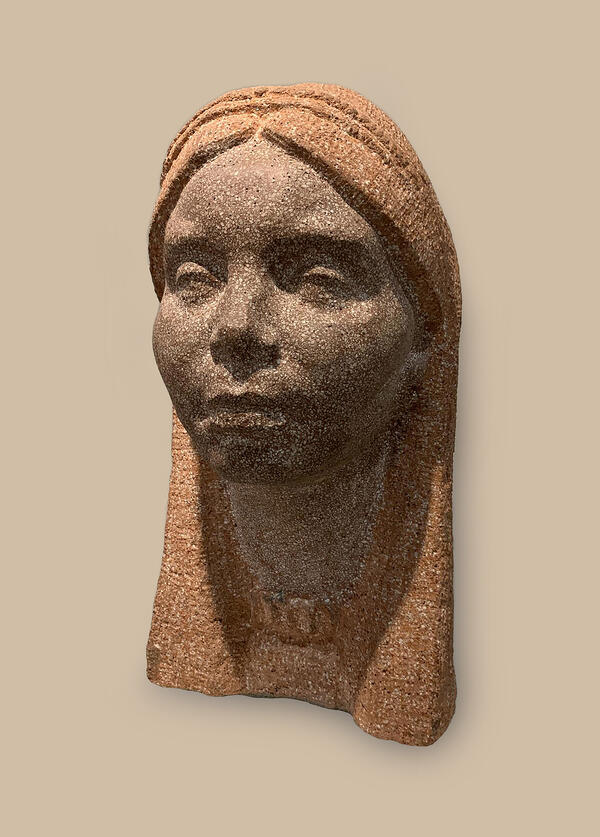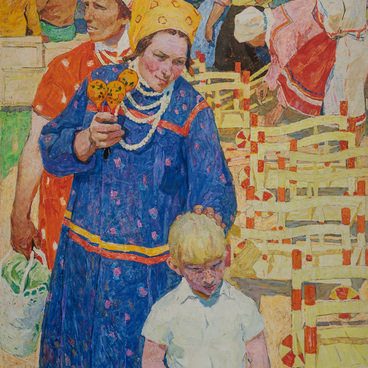Honored Artist of the Mordovian ASSR, the sculptor Nikolay Obukhov was a veteran of the Great Patriotic War. He created indoor and monumental sculpture. The monumental approach can be noticed in his indoor pieces and in his small figures.
The sculpture in the round is executed in the genre of portrait and is notable for its visual completeness. The figure, excluded from the historical context, appears to be a timeless character. The sculptor reveals the image not by means of an ethnic costume or headdress, but through anthropology and mentality. The artist, who avoids the signs of everyday routine, creates a deeply national image not only by conveying the external ethnic features, but also by displaying the national character and the inner world of a young woman. The image of a strong-willed person with inner strength and calm dignity, as well as internal significance, is interpreted by the sculptor with bluntness. This approach was characteristic of Soviet sculpture in the 1960s, which changed the artistic perspective: the admiration of severe heroism was replaced by immersion in the inner world of a person. At the same time, the sculptor emphasizes the vitality, harmony and life-giving nature of the female image. He creates a pure character full of untapped vital forces. The Smooth silhouette, soft and thoughtful expression of the face show reverie and light sadness inherent in the girl’s soul. Despite all the monumentality of the image, it has light attractive power and is perceived as an image of the youth itself with a quivering romantic belief in happiness.
Even in women’s portraits the sculptor reveals massive details. He works with large generalized planes, demonstrating the dense texture of the material, bringing them together with a somewhat heavy and archaic “Middle Eastern” monumentality. This is also referred to as the general geometry of shapes — a combination of a high pyramid (the neck) and a massive sphere (the head). The elongation of the neck is emphasized by two symmetrical cone-like folds of the shawl. Enlarged and regular shapes as well as solid texture of the cast stone bring monumental grandeur to this small piece of art. The beautifully constructed static composition is perfect in softness and warm in texture. It is an integral entity with a generalized, soft modeling of the face.
The sculpture in the round is executed in the genre of portrait and is notable for its visual completeness. The figure, excluded from the historical context, appears to be a timeless character. The sculptor reveals the image not by means of an ethnic costume or headdress, but through anthropology and mentality. The artist, who avoids the signs of everyday routine, creates a deeply national image not only by conveying the external ethnic features, but also by displaying the national character and the inner world of a young woman. The image of a strong-willed person with inner strength and calm dignity, as well as internal significance, is interpreted by the sculptor with bluntness. This approach was characteristic of Soviet sculpture in the 1960s, which changed the artistic perspective: the admiration of severe heroism was replaced by immersion in the inner world of a person. At the same time, the sculptor emphasizes the vitality, harmony and life-giving nature of the female image. He creates a pure character full of untapped vital forces. The Smooth silhouette, soft and thoughtful expression of the face show reverie and light sadness inherent in the girl’s soul. Despite all the monumentality of the image, it has light attractive power and is perceived as an image of the youth itself with a quivering romantic belief in happiness.
Even in women’s portraits the sculptor reveals massive details. He works with large generalized planes, demonstrating the dense texture of the material, bringing them together with a somewhat heavy and archaic “Middle Eastern” monumentality. This is also referred to as the general geometry of shapes — a combination of a high pyramid (the neck) and a massive sphere (the head). The elongation of the neck is emphasized by two symmetrical cone-like folds of the shawl. Enlarged and regular shapes as well as solid texture of the cast stone bring monumental grandeur to this small piece of art. The beautifully constructed static composition is perfect in softness and warm in texture. It is an integral entity with a generalized, soft modeling of the face.





